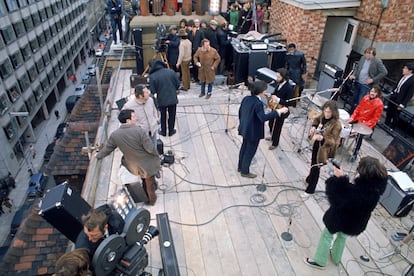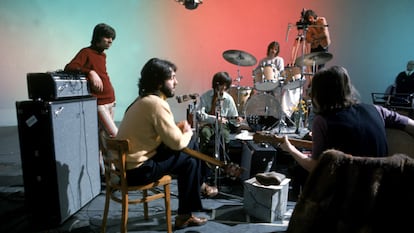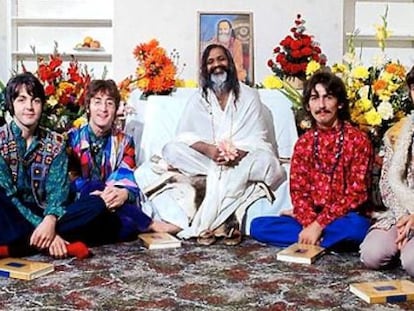‘Let It Be’: The cursed Beatles film makes a luminous comeback
In the context of 1970, Lindsay-Hogg’s film was the chronicle of a band in disarray. Disney has released a version restored by Peter Jackson’s team, which today is seen as a display of talent
Unlike their idol Elvis Presley, the Beatles never stopped their fruitful musical career to make films. They prioritized recording in the studio to push their albums to the next level. But they did leave behind a handful of films: two light comedies (A Hard Day’s Night and Help!), a cartoon fantasy (Yellow Submarine), which they had little involvement with; a disconcerting psychedelic made-for-television musical film (Magical Mystery Tour). And Let It Be, the cursed film, the documentary that was seen at the time as a chronicle of the band’s demise.
Let It Be was recorded during the band’s sessions in January 1969, which were very stressful for the Liverpool four, who were uncomfortable being filmed at all hours. The footage was left in a drawer. And it was not released (as an album and as a film) until May 1970, when Paul McCartney had already announced (just a month before) the end of the band. The feature film was met with bitterness: audiences could not see it without thinking of the band’s sudden breakup. Nor was it supported by any of the four Beatles, who already had their solo albums ready: when it was awarded the Oscar for best soundtrack, they tasked symphony conductor Quincy Jones to accept the award. The album was not received any more positively: McCartney disowned it, dissatisfied with Phil Spector’s production, which he considered excessive, and in 2003, he released his own version called Naked, without the mark of the “Wall of Sound” creator.
The stain on Let It Be has been so long-lasting that at the beginning of the digital era, the film disappeared from catalogs. It was not on any TV platform, collectors searched for traces of it on old DVDs and fans had to resort to piracy. Until now. On Wednesday, Disney+ releases the film directed by Michael Lindsay-Hogg, which has been remastered by Peter Jackson’s Park Road Post Production.
The director of The Lord of the Rings spent the pandemic working on the original tapes of the film — 60 hours of video and 150 of audio — to make the documentary Get Back, which was released by Disney in 2021. Get Back used the most advanced technologies, as well as artificial intelligence, to polish the footage. The work resulted in a nearly eight-hour documentary, divided into three episodes, packed with interesting, never-before-seen material. The next step was to restore Let It Be. And, with today’s eyes, the result is much more positive.
The image quality has improved notably (although some critics say that the use of color has been abused); the sound has been cleaned up of noise and is crystal clear. What’s most valuable, what is not seen in The Beatles’ other films, is that the movie places the viewer in the studio with four guys who haven’t even turned 30, who have boundless creativity and come up with song after song. There’s still chemistry between John Lennon and Paul McCartney, and it’s George Harrison who rebels against his secondary role. Out of those apparently chaotic sessions came the Let It Be album, as well as a number of tracks on Abbey Road (their next project, their real farewell, which ended with the song The End). But Abbey Road was released in November 1969, and was very well received, while Let It Be took six months more to come out and hit stores at a bad time. Those three weeks in the studio also produced songs that were released later in their solo careers, and a lot of others that were discarded (such as Suzie Parker).
The beginning of the new version of Let It Be includes a brief dialogue between Lindsay-Hogg and Jackson (who does not appear in the credits other than in the acknowledgments). The director of the original film explains that he was intending to make a documentary about the Beatles’ return to the stage. The Fab Four had not performed in front of an audience since 1966: they were focused on innovating in the studio. For their comeback on stage, they wanted to go big and discussed overambitious ideas, such as to play in a Roman amphitheater in Libya. The director filmed the studio sessions, thinking that this would be secondary material, that the central part of the film would be the concert. Jackson can’t help but express his envy: he himself worked with that material and knew all those songs well, but Lindsay-Hogg had the privilege of witnessing how they were created in front of his cameras.

The Beatles went through stages very quickly: when others groups were catching up, the band was already moving on to something else. By the beginning of 1969, they had finished their psychedelic experimentation, and their White Album of the previous year marked their return to classic rock. It is clear in the film that they feel a certain need to return to their origins: they play old songs (including One After 909, written by Lennon when he was 15 years old!), rock and roll standards and even a cover of Bésame Mucho. The group is seen trying to recover the spirit of Hamburg or The Cavern, where they played many concerts before becoming famous.
When putting together Let It Be, Lindsay skipped much of the material about the band’s relationship and prioritized footage of them making music. At eight hours long, Get Back has much more time to delve into the story. There is another attractive feature in Jackson’s 2021 production: it allows the viewer to understand the creative process behind each song, from a simple hum to a perfect track.
Let It Be is more about enjoying the music, and with a running time of 80 minutes, is likely to be more accessible than an eight-hour documentary for diehard fans. But the movie does include footage of their studio improvisations and conversations, where some tension is seen. It is clear that Paul has taken the reins, while John has become less involved.
There are iconic moments, such as Lennon and Yoko Ono dancing, while Harrison sings I Me Mine, an intense jam session that gives rise to the song Dig It, and a brief argument, when Harrison confronts McCartney: “I’ll play whatever you want me to play, or I won’t play at all if you don’t want me to play. Whatever it is that will please you, I’ll do it.” After that argument, Harrison disappeared for six days. Neither in Let It Be or in Get Out is it clear what Ringo Starr, sheltered in a secondary role, thinks of all this.
Harrison’s frustration with the Let It Be experiment ended up ruining the idea of playing in an amphitheater in Libya. But Lindsay-Hogg had set out to film the making of a concert film, so there had to be one. In the end, The Beatles performed on the rooftop of Apple Corp’s London studios, a smaller affair that nevertheless went down in history.
At first, when the music thunders down from the roof, only a few curious people stop on the street. There is confusion as to whether it is really The Beatles, because the public hadn’t heard the new songs they were playing. Other people manage to climb to other nearby rooftops to watch in disbelief. But after just 42 minutes, there was a sizeable crowd on the sidewalks, under the tense gaze of police officers. Lennon says goodbye on behalf of the band with his usual sarcasm: “I hope we’ve passed the audition.” Did he sense that it was their last performance together? John, who had founded The Beatles, never got over the fact that it was Paul who announced its breakup.
More than half a century later, Let It Be can be watched without regret over the band’s end. The viewer can enjoy watching musicians of unmatched creativity, who enter a studio with no plan and come out with material for more than two albums, including many legendary songs.
With Let It Be, Disney is continuing with its plan to make the most out of The Beatles franchise, just as it does with the Marvel universe and Star Wars. More projects about the Liverpool quartet are on the way: Sony has announced four biopics for 2027, one for each of its members, all directed by Sam Mendes. The industry knows that it is very difficult for Beatles fans to tire of them.
Sign up for our weekly newsletter to get more English-language news coverage from EL PAÍS USA Edition
Tu suscripción se está usando en otro dispositivo
¿Quieres añadir otro usuario a tu suscripción?
Si continúas leyendo en este dispositivo, no se podrá leer en el otro.
FlechaTu suscripción se está usando en otro dispositivo y solo puedes acceder a EL PAÍS desde un dispositivo a la vez.
Si quieres compartir tu cuenta, cambia tu suscripción a la modalidad Premium, así podrás añadir otro usuario. Cada uno accederá con su propia cuenta de email, lo que os permitirá personalizar vuestra experiencia en EL PAÍS.
¿Tienes una suscripción de empresa? Accede aquí para contratar más cuentas.
En el caso de no saber quién está usando tu cuenta, te recomendamos cambiar tu contraseña aquí.
Si decides continuar compartiendo tu cuenta, este mensaje se mostrará en tu dispositivo y en el de la otra persona que está usando tu cuenta de forma indefinida, afectando a tu experiencia de lectura. Puedes consultar aquí los términos y condiciones de la suscripción digital.
More information
Archived In
Últimas noticias
Most viewed
- Oona Chaplin: ‘I told James Cameron that I was living in a treehouse and starting a permaculture project with a friend’
- Sinaloa Cartel war is taking its toll on Los Chapitos
- Reinhard Genzel, Nobel laureate in physics: ‘One-minute videos will never give you the truth’
- Why the price of coffee has skyrocketed: from Brazilian plantations to specialty coffee houses
- Silver prices are going crazy: This is what’s fueling the rally












































